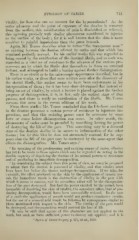Page 731 - My FlipBook
P. 731
ETIOLOGY OF CARIES. 741
vitality, for how else can we account for the hyperesthesia ? As the
caries advances and the point of exposure of the dentine is removed
from the surface, this manifestation of pain is diminished or relieved,
this agreeing precisely with similar phenomena manifested in injuries
to the surface of the body ; for it is well known that the skin is more
sensitive to painful impressions than the parts beneath.
"
Again, Mr. Tomes describes what he terms " the transparent zone
as existing between the dentine affected by caries and that which has
remained perfectly normal. In his earlier works this was regarded as
being caused by the calcification of the dentinal fibrils, and as such was
regarded as a vital act of resistance to the advance of the carious pro-
cess—an act by which the fibrils shut themselves in from an external
irritant, and attempted to build a barrier against further disintegration.
There is no doubt as to the microscopic appearances described, but in
his earlier works, or those that were written soon after the discovery of
the dental fibrils, this author seems to have been unfortunate in his
interpretation of them ; for it has been since determined that instead of
being an act of vitality," by which a barrier is placed against the further
progress of disintegration, it is, in fact, only the earliest stage of that
process, and there is really no calcification of the fibrils. Mr. Tomes
corrects this error in the recent editions of his work.
From these studies Mr. Tomes concluded that the life-force resident
in the dentine possesses a certain power of resistance to injurious im-
pressions, and that this resisting power must be overcome by some
force or cause before disintegration can occur. In other words, the
phenomena of caries must be preceded by something having the power
of destroying the life of the part. This something may be a diseased
state of the dentine similar in its nature to inflammation of the other
tissues ; but for this idea he does not strenuously contend, for he sup-
poses that the life of the part may be destroyed by the same agent that
^
effects the disintegration. Mr. Tomes says :
" In speaking of the predisposing and exciting causes of caries, allusion
has yet to be made to those agents which may be regarded as acting in the
double capacity of depriving the dentine of its normal powers of resistance
and of producing its immediate decomposition.
" In considering the subject from this point of view, we must be prepared
to admit that the dentine is possessed of vitality, and that vitality must
have been lost before the tissues undergo decomposition. If we take, for
example, the effect produced on the skin by the application of caustic pot-
ash, the immediate result is the destruction of vitality in the part with
which it comes in contact, and its secondary effect will be the disorganiza-
tion of the part destroyed. But had the power exerted by the potash been
incapable of depriving the skin of vitality, the secondary effect, that of pro-
ducing decomposition, would have been successfully resisted. In the case
of a tooth the application of potash would not produce conclusive results,
but the use of a mineral acid would be followed by consequences similar to
those mentioned with respect to the skin. The vitality of the part would
be destroyed, and decomposition would succeed the loss of life.
" It may be said that agents of this character are not applied to the
teeth, but such as have sufficient power to destroy are applied ; and it is
^ System of Dental Surgery, p. 372, 3d ed., 1859.


